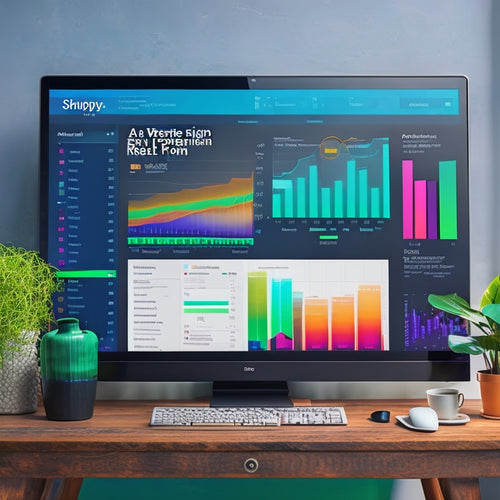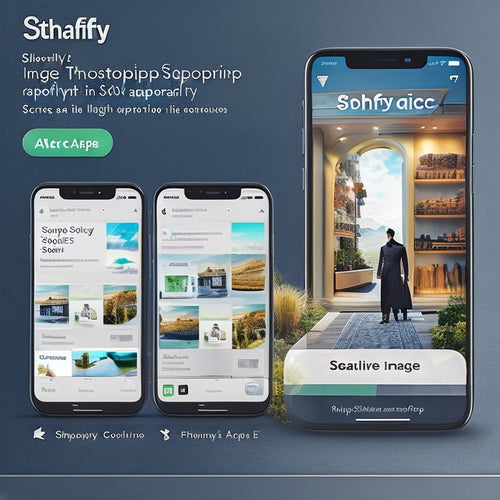
7 Best Digital Product Strategies for Profitable Sales
Share
You can boost your digital product sales by up to 300% by implementing a combination of strategies that resonate with your target audience, differentiate your product from competitors, and build trust with your customers. Start by identifying your target audience and creating valuable digital assets that meet their needs. Develop a unique selling proposition that sets you apart, and build trust through content marketing and email campaigns. Utilize webinars for product launch and offer upsells and cross-sells strategically. By following these 7 digital product strategies, you'll be well on your way to profitable sales - and discovering the secrets to maximizing your revenue potential.
Key Takeaways
• Identify and understand your target audience's needs, pain points, and behaviors to design products that meet their expectations.
• Develop a unique selling proposition (USP) that differentiates your product from competitors and resonates with the market.
• Create valuable digital assets such as e-books, webinars, and videos that provide value, educate, and entertain your audience.
• Build trust with your audience through content marketing, email marketing campaigns, and live Q&A sessions that address their pain points and objections.
• Strategically offer upsells and cross-sells to segmented customers, experimenting with pricing for revenue optimization and increasing customer lifetime value.
Identify Your Target Audience
To develop a profitable digital product, you must first identify your ideal customer, understanding their needs, pain points, and behaviors to tailor your product strategy effectively. This essential step lays the foundation for a successful product launch.
To get started, understand your target audience's demographics, including age, gender, location, and occupation. Conduct surveys or gather data from social media, online forums, and customer reviews to gain valuable insights. Analyze their pain points, what keeps them up at night, and what motivates them to make a purchase.
Identify their behaviors, such as how they interact with similar products or services. By gathering and analyzing this data, you'll create buyer personas that will guide your product development. With a clear understanding of your target audience, you'll be able to design a product that meets their needs, solves their problems, and exceeds their expectations.
This data-driven approach will increase your chances of creating a profitable digital product that resonates with your target audience.
Create Valuable Digital Assets
With your target audience firmly in mind, you can now focus on creating valuable digital assets that resonate with them and meet their specific needs. This is where content creation comes into play. You'll want to develop a content strategy that speaks directly to your audience's pain points, interests, and motivations. This could include e-books, webinars, videos, podcasts, or even online courses. The key is to create digital assets that provide value, educate, or entertain your audience.
When creating these assets, consider how you can repurpose or upsell them in the future. This will help you maximize your ROI and create multiple monetization strategies. For example, you could turn a popular blog post into a video series or a podcast episode. Or, you could create a paid online course based on a free e-book.
Develop Unique Selling Proposition
To develop a unique selling proposition, you need to identify what sets your digital product apart from the competition.
You'll want to pinpoint the specific problems it solves that others don't and highlight the key benefits that make it a game-changer for your customers.
Stand Out From Crowd
Your unique selling proposition (USP) serves as a differentiator, setting your digital product apart from the competition and giving customers a compelling reason to choose it over others. It's the secret sauce that makes your product stand out in a crowded market. By developing a strong USP, you'll create brand differentiation that resonates with your target audience, providing a superior customer experience that drives loyalty and retention.
To stand out from the crowd, you need a competitive advantage that sets you apart from the competition. Your USP should be rooted in your product's unique features, benefits, or values that solve specific pain points or meet particular needs. By owning a specific market positioning, you'll appeal to a specific segment of the market, establishing your product as the go-to solution.
For instance, if your digital product offers personalized AI-driven recommendations, that's a unique selling point that sets you apart from generic recommendation engines. By highlighting this USP, you'll attract customers who value tailored experiences, giving you a competitive edge in the market.
Solve Unique Problems
By pinpointing the unique problems your target audience faces, you can develop a digital product that solves these pain points and creates a compelling USP that resonates with them.
To develop innovative solutions that truly meet your customers' needs, you need to understand their pain points. Here are some ways to do just that:
-
Analyze customer feedback:
Collect and analyze feedback from various channels, such as social media, reviews, and support tickets, to identify common complaints and areas of frustration. -
Conduct surveys and polls:
Ask your target audience directly about their challenges and pain points to gain valuable insights. -
Research industry reports:
Stay up-to-date with the latest industry trends and reports to identify gaps in the market that your product can fill.
-
Talk to your customers:
Engage with your customers through one-on-one interviews or focus groups to gain a deeper understanding of their needs and pain points.
Highlight Key Benefits
Developing a unique selling proposition (USP) that highlights the key benefits of your digital product enables you to differentiate it from competitors and resonate with your target audience. By doing so, you'll be able to communicate the value your product offers, setting it apart from the competition.
A well-crafted USP helps you connect with your ideal customer on an emotional level, making them more likely to take action. To create an effective USP, identify what sets your product apart and how it solves a specific problem for your customer. Then, distill that down into a concise, compelling message that speaks to their needs.
When you highlight the key benefits of your digital product, you'll increase conversions by giving customers a clear reason to buy. A strong USP also drives engagement by sparking curiosity and encouraging customers to learn more. By making your product's benefits clear and compelling, you'll attract more customers and ultimately drive revenue.
Build Trust With Content Marketing
Craft a content marketing strategy that showcases your brand's expertise and provides value to potential customers, thereby establishing trust and credibility in the market. You can achieve this by creating high-quality, informative, and engaging content that addresses the pain points of your target audience. This will help you build a loyal community that trusts your brand and is more likely to convert into paying customers.
To take your content marketing strategy to the next level, focus on the following:
-
Social media engagement: Share your content on social media platforms and encourage discussions and interactions with your audience.
-
Customer testimonials: Use customer success stories and testimonials to build credibility and trust with potential customers.
-
Influencer partnerships: Collaborate with influencers in your industry to expand your reach and build credibility with their followers.
- Community building: Create a community around your brand by hosting webinars, events, and online forums where customers can interact with each other and with your brand.
Leverage Email Marketing Campaigns
You can tap into the potential of email marketing campaigns to nurture leads and drive conversions by sending targeted, personalized messages that resonate with your audience. By segmenting your email list, you can create tailored content that speaks directly to specific groups, increasing engagement and conversion rates.
For instance, you can create separate campaigns for new subscribers, loyal customers, or abandoned cart reminders. This approach allows you to craft personalized content that addresses specific pain points, increasing the likelihood of a sale.
To take your email marketing to the next level, incorporate automation and drip sequences into your strategy. These tools enable you to send targeted messages at the right time, without manual intervention.
For example, you can set up a welcome series that sends a sequence of emails to new subscribers, or a cart abandonment sequence that reminds customers about their forgotten items. By leveraging automation and drip sequences, you can maximize your email marketing ROI and drive profitable sales.
Utilize Webinars for Product Launch
When you utilize webinars for your product launch, you're creating a prime opportunity to build pre-launch hype and generate buzz around your product.
By hosting live Q&A sessions, you'll not only address potential customers' concerns but also showcase your product's value and benefits.
Pre-Launch Hype Creation
Building anticipation among potential customers is essential, and leveraging webinars as a pre-launch strategy can generate significant buzz around your product, positioning it for a profitable sale. By hosting webinars, you can create a sense of exclusivity and build a community of interested customers who are enthusiastic to learn more about your product.
Here are some ways to create pre-launch hype using webinars:
-
Tease your product: Share behind-the-scenes content, sneak peeks, or demos to create curiosity and excitement.
-
Collaborate with influencers: Partner with industry thought leaders or social media influencers to expand your reach and credibility.
-
Utilize social media: Promote your webinars on social media platforms to reach a wider audience and create a buzz around your product.
- Offer exclusive access: Provide webinar attendees with exclusive access to your product or a special offer to create a sense of urgency.
Live Q&A Sessions
Sixty-seven percent of customers report that live Q&A sessions greatly impact their purchasing decisions, making them an essential component of your product launch webinar strategy. By incorporating live Q&A sessions into your webinar, you can engage customers, gather feedback, and address any concerns they may have. This not only builds trust but also helps to increase conversions.
Here are some key benefits of live Q&A sessions:
| Benefits | Description |
|---|---|
| Increased Engagement | Encourages customers to participate and ask questions |
| Improved Trust | Builds trust by providing transparent and honest answers |
| Reduced Objections | Addresses concerns and objections, increasing conversions |
| Valuable Feedback | Provides valuable insights for future product development |
Offer Upsells and Cross-Sells Strategically
By incorporating strategic upsells and cross-sells into your digital product offerings, you can boost average order value and increase customer lifetime value. This approach allows you to offer customers more value while maximizing revenue.
To do this effectively, consider the following strategies:
-
Segment your customers: Identify high-value customers and tailor your upsells and cross-sells to their specific needs and preferences.
-
Experiment with pricing: Test different price points to find the sweet spot that drives the most revenue.
-
Offer personalized recommendations: Use data-driven insights to suggest products that complement their initial purchase.
- Bundle products strategically: Package related products together to increase average order value and enhance the customer experience.
Frequently Asked Questions
How Do I Handle Negative Feedback From Customers Online?
When handling negative feedback online, you'll want to prioritize customer satisfaction by responding promptly, apologizing sincerely, and offering solutions, all while maintaining a strategic focus on reputation management and online review management.
Can I Use Digital Product Strategies for Physical Products Too?
"When in Rome, do as the Romans do." You can absolutely apply digital strategies to physical products, focusing on product differentiation and market segmentation to increase sales. Leverage cross-selling and upselling tactics to maximize revenue.
What Is the Ideal Length for a Sales Funnel Sequence?
You'll find the ideal sales funnel sequence length varies, but aim for 7-10 touchpoints to optimize conversion rates. Focus on email marketing and customer retention to guarantee a 20-30% open rate, and adjust based on data-driven insights.
How Often Should I Update My Digital Product Offerings?
You should update your digital product offerings every 6-12 months to maintain customer engagement, leveraging product refresh cycles that align with evolving customer needs and stay ahead of the competition.
Can I Use Digital Product Strategies for B2B Sales?
You're finding your way through a maze, searching for the perfect route. Yes, you can use digital product strategies for B2B sales, leveraging targeted digital marketing strategies to reach decision-makers and drive conversions in the intricate B2B marketing landscape.
Related Posts
-

Boost Customer Loyalty With 3 Proven Strategies
You're about to reveal the secret to turning casual customers into loyal advocates. Three proven strategies can help ...
-

How Do I Improve SEO on My Shopify Website
This article examines methods to enhance search engine optimization (SEO) on Shopify websites. It begins by discussi...
-

Essential SEO Apps for Shopify: Boost Your Store's Visibility
This article explores the significance of SEO apps for Shopify stores in enhancing visibility and ranking in search ...


